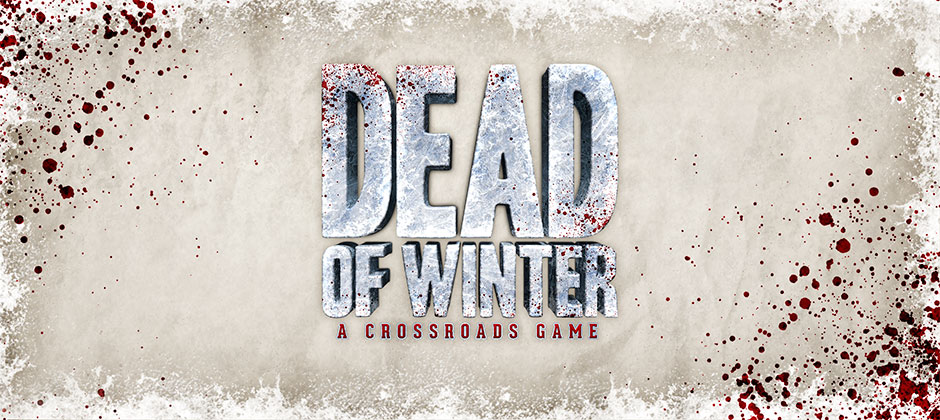
That is not how we do things. We give people a choice. It’s theirs to make regardless of the outcome.
It’s cold, everyone’s hungry, and there are dead things outside that are even hungrier. Curl up by the fire with the Dead of Winter review!
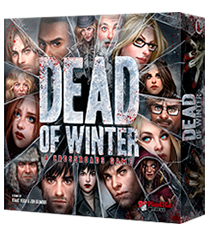 No. Please no. Not zombies again. NOT ZOMBIES AGGGGAAAAAIIIIINNNNNN!!!!!! Such is the cry you’ll hear, torn from the throats of gamers the world over every time they check Boardgamegeek and see another zombie game. NO MORE ZOMBIES! Truly, this is a genre which has been done to (living) death. Not only has it been raked over a million times, but most of the games follow the same tired old sequence—search for items, kit up, shoot zombies, find the chopper, get out alive. Surely Plaid Hat Games couldn’t have pasted these tired tropes on their latest release. Please tell me they haven’t made just another zombie game?
No. Please no. Not zombies again. NOT ZOMBIES AGGGGAAAAAIIIIINNNNNN!!!!!! Such is the cry you’ll hear, torn from the throats of gamers the world over every time they check Boardgamegeek and see another zombie game. NO MORE ZOMBIES! Truly, this is a genre which has been done to (living) death. Not only has it been raked over a million times, but most of the games follow the same tired old sequence—search for items, kit up, shoot zombies, find the chopper, get out alive. Surely Plaid Hat Games couldn’t have pasted these tired tropes on their latest release. Please tell me they haven’t made just another zombie game?
Thankfully, no. This is not just another zombie game. In fact, the zombies are pressing up against the windows while the main drama plays out inside. In the wake of The Walking Dead, the zombie genre is more about the interaction of humans under extreme pressure, and Dead of Winter feels like the first zombie game to really explore this concept. In this game, you’re going to find out just how prepared you are to make the hard choices—because survival is all about the hard choices.
Dead of Winter arrived on a wave of positive press and has largely lived up to the hype. People like Plaid Hat Games: Colby Dauch and his crew are obviously a bunch of nice people who really enjoy games, and boardgamers respond to their enthusiasm and honesty. It’s an open, one-on-one communication with their fans that is very much in the spirit of modern business, and it’s taking the company from strength to strength. But the games have got to be good too, and this one is, even though I have one small doubt that niggles like a detached zombie hand clawing at my ankle.
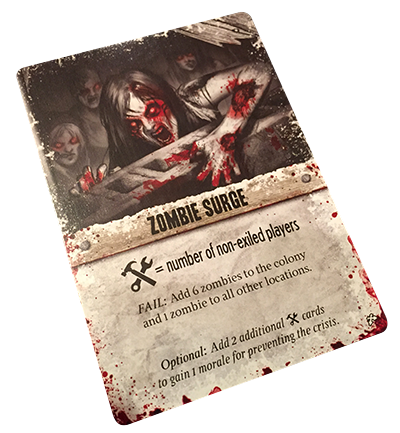 One of the great things about the Dead of Winter is the relatively straightforward rules, which are very intuitive and seem to flow naturally from the theme. Players start with two survivors, a reference sheet, and a secret objective card each. One main objective card is chosen for the game (more on objectives later). Each round starts with the reveal of a crisis card. In a mechanic similar to the one from Battlestar Galactica, players can play cards to the crisis during their turns in an attempt to forestall the negative effect of the card. For example, the card shown to the left requires a number of tool cards equal to the number of players. Cards played to the crisis go onto a facedown pile and are shuffled before being revealed, so there’s an opportunity for a traitorous player to play the wrong cards and bring on the crisis.
One of the great things about the Dead of Winter is the relatively straightforward rules, which are very intuitive and seem to flow naturally from the theme. Players start with two survivors, a reference sheet, and a secret objective card each. One main objective card is chosen for the game (more on objectives later). Each round starts with the reveal of a crisis card. In a mechanic similar to the one from Battlestar Galactica, players can play cards to the crisis during their turns in an attempt to forestall the negative effect of the card. For example, the card shown to the left requires a number of tool cards equal to the number of players. Cards played to the crisis go onto a facedown pile and are shuffled before being revealed, so there’s an opportunity for a traitorous player to play the wrong cards and bring on the crisis.
Next, everyone rolls a number of action dice equal to the number of characters they have, plus one, and places these dice results on their reference sheets. In the following player turns, you can spend these results to perform various actions; either spending a die with any result (to build a barricade, clean up waste cards at the colony, attract zombies to your location, add food to the colony, etc) or spending a die with a specific result that equals or beats one of your survivor’s relevant values (to attack, or search). It’s a simple and flexible system that’s interesting and efficient in that you roll the dice first and then assign them afterwards (rather than, for example, choosing to attack and then rolling a die), and also has the advantage of making it easy to keep track of the number of actions your survivors share in a round. Playing a special card, adding a card to the crisis pile, or moving a survivor can all be done without spending an action die.
The bitten survivor is instantly killed, and another survivor in the same location has to make a horrible decision
The main colony board is surrounded by six other locations that survivors can visit to scrounge for supplies. This seems to be a simple matter of moving there and searching, but this is the dead of winter after all and there are zombies out there, so just moving from location to location can be an incredibly risky endeavour for your struggling survivors. Welcome to the dreaded exposure die (dum-da-da-dummmmmm …), a red 12-sided die that you’ll soon come to hate. You must roll this die every time one of your survivors moves (unless you spend a Fuel Can card), and the results can be devastating: you might be lucky and come off unscathed, but you might also be wounded, frostbitten (which means you’ll take an additional wound every subsequent round), or worst of all, bitten by a zombie. And zombie bites can spread to other survivors. In a particularly nasty bit of game design, the bitten survivor is instantly killed, and another survivor in the same location has to make a horrible decision: sacrifice his survivor and stop the spread of the infection, or roll the die again and gamble on rolling a blank. If a blank doesn’t come up, that survivor dies and the infection spreads again. Ouch, that hurts.
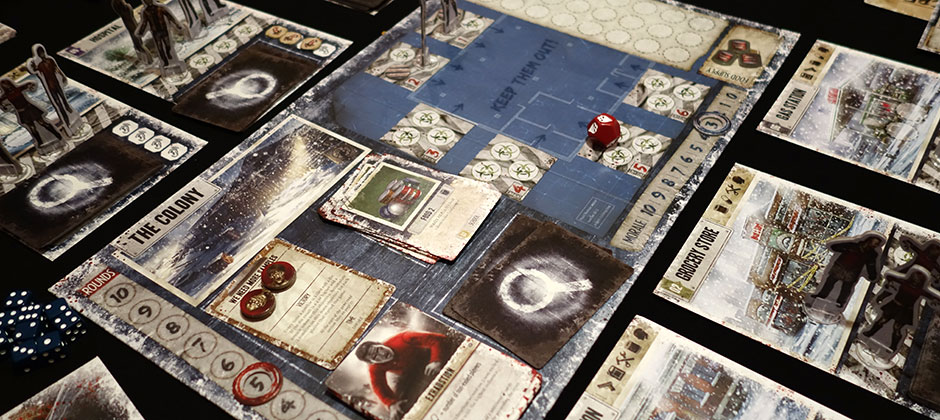 But what’s this whole ‘crossroads’ thing about, I hear you ask? Well, it’s a big deck of 80 cards that add some wonderfully thematic flavour to the grim business of survival during a zombie apocalypse. Every time a player takes a turn, the player to his or her right draws a crossroads card. Instead of just drawing an event card and resolving it, as happens in so many games, the crossroads card is only resolved when its ‘trigger’ occurs: for example, if the player whose turn it is moves a survivor, or they have a particular named survivor, or some other specific event takes place. If the trigger happens, the crossroads card is read out, and the player has to make a choice, usually between a couple of options. This is where things really get fun, because some of these choices can really be agonising. Should you go searching for that lost girl, even though it will cost you valuable resources and put your colony members at risk? Do you take in that teenage girl with her newborn baby, even though its cries are attracting the living dead? Do you kick that sick and helpless survivor out of the colony or does everyone take the risk of catching the infection? These are the kinds of tough decisions real survivors would have to make, and at these times when Dead of Winter suddenly shifts from being a fun way to spend an hour or two with some friends around a boardgame to something that makes you seriously contemplate “what would I do in that situation?” Thankfully, the writing doesn’t gloss over the grim realities: there’s an icon on some cards which warns you they deal with “mature themes like sex, language, suicide, alcohol abuse, etc.” so if you or your players are easily offended you can remove those cards from the game.
But what’s this whole ‘crossroads’ thing about, I hear you ask? Well, it’s a big deck of 80 cards that add some wonderfully thematic flavour to the grim business of survival during a zombie apocalypse. Every time a player takes a turn, the player to his or her right draws a crossroads card. Instead of just drawing an event card and resolving it, as happens in so many games, the crossroads card is only resolved when its ‘trigger’ occurs: for example, if the player whose turn it is moves a survivor, or they have a particular named survivor, or some other specific event takes place. If the trigger happens, the crossroads card is read out, and the player has to make a choice, usually between a couple of options. This is where things really get fun, because some of these choices can really be agonising. Should you go searching for that lost girl, even though it will cost you valuable resources and put your colony members at risk? Do you take in that teenage girl with her newborn baby, even though its cries are attracting the living dead? Do you kick that sick and helpless survivor out of the colony or does everyone take the risk of catching the infection? These are the kinds of tough decisions real survivors would have to make, and at these times when Dead of Winter suddenly shifts from being a fun way to spend an hour or two with some friends around a boardgame to something that makes you seriously contemplate “what would I do in that situation?” Thankfully, the writing doesn’t gloss over the grim realities: there’s an icon on some cards which warns you they deal with “mature themes like sex, language, suicide, alcohol abuse, etc.” so if you or your players are easily offended you can remove those cards from the game.
The rules instruct you read out all the options available to a player on a crossroads card, but alternatively, and perhaps more thematically, there’s nothing to stop players deciding not to be warned of the consequences of their choices, and though I’m not sure if this unbalances the game, it might be a fun option for experienced players. By the way, I’ve found during the heat of the game that it’s easy to forget to pick up a crossroads card each time a player takes a turn: I recommend putting the deck in a prominent central position to as a reminder.
Finally, there’s a Colony Phase where the overall ante is upped: you must pay food from the food supply to feed survivors (including helpless survivors) at the colony, resolve the current round’s crisis for good or ill, and of course, add zombies to the inexorable tide of living dead. Once those shambling uglies start filling up locations people are going to start dying, so make sure you keep their numbers to a manageable level!
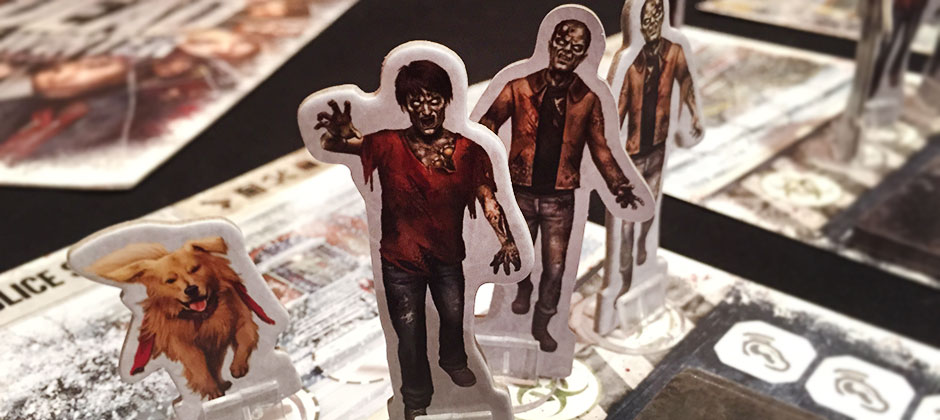 Given all the forces—exposure, zombies, poor decision-making—arrayed against the players, how do you win a game of Dead of Winter? Well, one main objective card is drawn at the start of the game, but each player also gets a secret objective card. Here’s where a bit of traitorous fun à la Shadows Over Camelot and Battlestar Galactica enters the proceedings. A number of ‘betrayal’ secret objective cards go into the secret objectives deck, and you may find yourself with an objective that doesn’t really match up with the colony’s consensus. Like you want morale to be at zero and your survivors need to have four guns (Trigger Happy) or at least two more survivors than any other player (Cult Leader). In any case the game ends if the morale track or the round track reaches zero, or the main objective is completed, so it can be a tricky balancing act making sure you have the right stuff to fulfil your secret objective when the game comes to an end. What’s more, if other players begin to suspect that you don’t have the interests of the colony in mind, they can vote to exile you from the colony. If this happens you immediately draw an exiled objective card that will adjust your objectives depending on whether or not you were a betrayer. You’ll be moving around on the periphery of the colony and not contributing to resolving its crises, but you’ll also be busy fulfilling your own path to victory.
Given all the forces—exposure, zombies, poor decision-making—arrayed against the players, how do you win a game of Dead of Winter? Well, one main objective card is drawn at the start of the game, but each player also gets a secret objective card. Here’s where a bit of traitorous fun à la Shadows Over Camelot and Battlestar Galactica enters the proceedings. A number of ‘betrayal’ secret objective cards go into the secret objectives deck, and you may find yourself with an objective that doesn’t really match up with the colony’s consensus. Like you want morale to be at zero and your survivors need to have four guns (Trigger Happy) or at least two more survivors than any other player (Cult Leader). In any case the game ends if the morale track or the round track reaches zero, or the main objective is completed, so it can be a tricky balancing act making sure you have the right stuff to fulfil your secret objective when the game comes to an end. What’s more, if other players begin to suspect that you don’t have the interests of the colony in mind, they can vote to exile you from the colony. If this happens you immediately draw an exiled objective card that will adjust your objectives depending on whether or not you were a betrayer. You’ll be moving around on the periphery of the colony and not contributing to resolving its crises, but you’ll also be busy fulfilling your own path to victory.
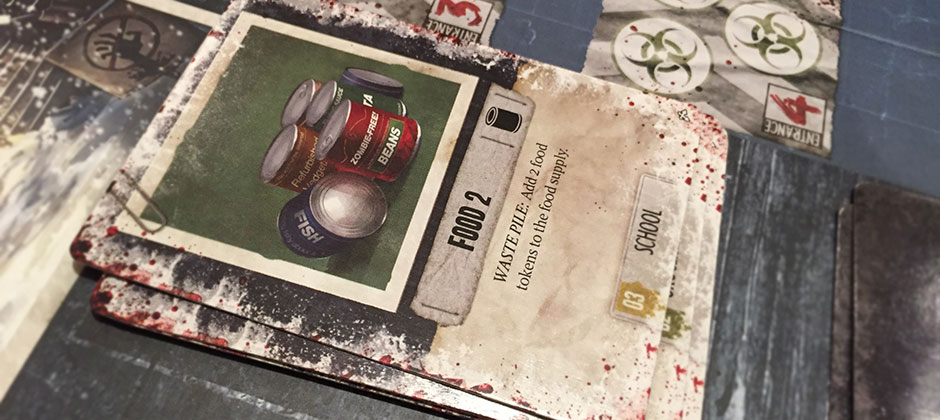 There’s a lot going on in Dead of Winter and I only have one niggling criticism: whether it all comes together to make a memorable game can sometimes be overly dependent on the luck of the draw and the luck of the dice. I have no problem with randomness in games, but we did play one 2-player game where we needed a certain amount of medicine to win, we drew a crossroads card that allowed us to choose from among the next five cards in the item deck, and we managed to score most of the cards we needed, resulting in a quick and anticlimactic ending. The risk of instant death every time you roll the exposure die (you also roll it when attacking zombies) is nerve-wracking, but a couple of suddenly dead survivors can really scuttle your plans and can sometimes feel like a too-drastic random penalty. When it all comes together though, the game is great fun, and the tension steadily climbs as locations slowly fill up with zombies, morale at the colony inevitably sinks (brilliantly, discarded cards go into a waste pile, and if no one spends an action to occasionally ‘take out the trash’ it affects morale), survivors are desperately searching for the cards they need, and on top of all that some crucial moral decision needs to be made that could make all the difference between victory or everyone becoming zombie takeout.
There’s a lot going on in Dead of Winter and I only have one niggling criticism: whether it all comes together to make a memorable game can sometimes be overly dependent on the luck of the draw and the luck of the dice. I have no problem with randomness in games, but we did play one 2-player game where we needed a certain amount of medicine to win, we drew a crossroads card that allowed us to choose from among the next five cards in the item deck, and we managed to score most of the cards we needed, resulting in a quick and anticlimactic ending. The risk of instant death every time you roll the exposure die (you also roll it when attacking zombies) is nerve-wracking, but a couple of suddenly dead survivors can really scuttle your plans and can sometimes feel like a too-drastic random penalty. When it all comes together though, the game is great fun, and the tension steadily climbs as locations slowly fill up with zombies, morale at the colony inevitably sinks (brilliantly, discarded cards go into a waste pile, and if no one spends an action to occasionally ‘take out the trash’ it affects morale), survivors are desperately searching for the cards they need, and on top of all that some crucial moral decision needs to be made that could make all the difference between victory or everyone becoming zombie takeout.
Quite apart from the fun factor, this is a game that makes you think “what if..?” Having read a few books detailing famous survival stories, it’s pretty clear that in the real world, as soon as you start sacrificing the weak and the helpless ‘for the greater good’ things start sliding quickly downhill for everyone. It may seem like the right decision to sacrifice moral and ethical concerns so the strong can survive, but it usually results in everyone turning on each other. You’re reminded of these issues in Dead of Winter, and you may even find yourself making surprising choices when the pressure is on.
It just goes to show that we did need another zombie game after all
Graphic design-wise, this is one of the best designed games all year. The visuals are remarkably professional and consistent throughout, the illustration is excellent, the rules are clear and well laid out (with one exception; it’s not listed what a crisis card with two icons separated by a slash means; it means any combination of those item types can be used to fulfil the condition), and personally I think the illustrated stand-ups are a fantastic alternative to the glut of plastic figure games on the market, since not everyone wants to paint plastic figures when they buy a boardgame. It’s one of those rare games where, being as I am a graphic designer with a perfectionist streak, I look at the design and think “I can’t think of anything they could have done to improve that design”. Plaid Hat should be proud of the visuals on this one.
Apparently there are plans for more Crossroads system games, and I’m looking forward to them, though I would like to see the luck factor mitigated just a little. With all the things players have to do to survive in Dead of Winter, it feels like you need to get just the right combination of pieces to solve the puzzle, but in fact it’s more of an hour or two of frantic reactions to an ever-escalating series of disastrous events, and a bit of bad luck can mean game over. As long as you know that going in and buckle up for the ride, there’s a wonderful time to be had.
It just goes to show that we did need another zombie game after all. We just needed a really good one—and Dead of Winter is it.
Good write-up. I’m looking forward to trying this out. Hopefully, it will be available for purchase before the holidays.
I love Dead of Winter.
Sounds like a formal, public declaration! 🙂
Finally got a hold of this game myself, looking forward to playing it. Have you thought about filming a battle report on this one Peter?
Unfortunately there’s a limited number of battle reports I can film, and I don’t think this one will fit on the list. Also, I tend to film two player games as flming multiple players introduces all kinds of logistical difficulties.
Two player prisoner dilemma is a fun go!
You’re right, I tried it the other day and it worked well. For people who don’t know, you can find it here.